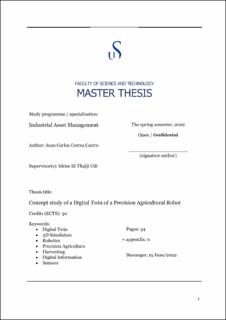| dc.description.abstract | When designing a digital twin, different properties are needed to be implemented so that the physical twin can be able to interact with the environment and fulfil the tasks that the physical asset was developed for. The methodology proposed in this thesis is of highly relevance when designing a digital twin solution, being simple to adapt to different necessities and with a clear architecture to utilize or to adjust to digital assets in different applications.
The digital twin developed in the case study, on which this thesis is based, is the foundation of the development and creation of an innovative table grape harvesting robot.
The main objective of this research is to review and identify potential methodologies that can be used in the design stage of a digital twin and to validate how the processes in the methodologies can support the system to fulfill the objectives of the project. The system involves the interactions between the robot, the environment, and the agronomical tasks that the robot needs to perform.
This thesis creates the methodologies that will assist different stakeholders in easily identifying the processes that streamline the testing procedure of different algorithms in the digital twin, saving time and resources by doing the development in the digital twin and not in the physical object.
The thesis assessed the challenges of limited testing time and transporting equipment and personnel difficulties to a fixed location, in this case, a vineyard located in Italy, defined later as the physical asset. It is of highly importance to incorporate the research structure to the digital twin development team early in the project's timeline. Based on the literature and discussion between stakeholders, the basic architecture was created, and from there, the cases defined in this thesis will allow the users and clients to test in a seamless way their products in the digital twin. The process gave the option to the users to select and use from a basic environment to a more complex and challenging one.
The purpose of the thesis was to present and document certain architecture and methodologies used in the research and present them as a base for future developments in the area. This method can be used for projects when physical assets need to be created and tested, when time periods for testing are part of the challenges of the project, and the availability to allocate and integrate resources is complex.
The main results and conclusion of this thesis is the methodology proposed, on how a simple processes and methodologies can be easily adapted to the necessities of any digital twin solution, and how the architecture proposed can have the ability to modify different cases for specific objectives. And finally, how it is possible to use, prepper and export the information needed to train the Machine learning (ML) algorithms, and to add noise specific to allow the evolution of the algorithms.
The methodology proposed in this thesis can increase the quality and usability of any digital twin by proving how it can be successfully implemented during the planning developing process of a project. Furthermore, the methodology demonstrate that it can be easily adapted to the necessities of any digital twin solution and streamlined the progress in the future use of digital twins in any area.
In the case study, the methodology helped all different stakeholders to utilize the digital twin to develop, test, and improve different algorithms from different locations through Europe without the need to build the physical robot, or being in one particular place, and without the restrictions of seasonal harvesting periods. | |
